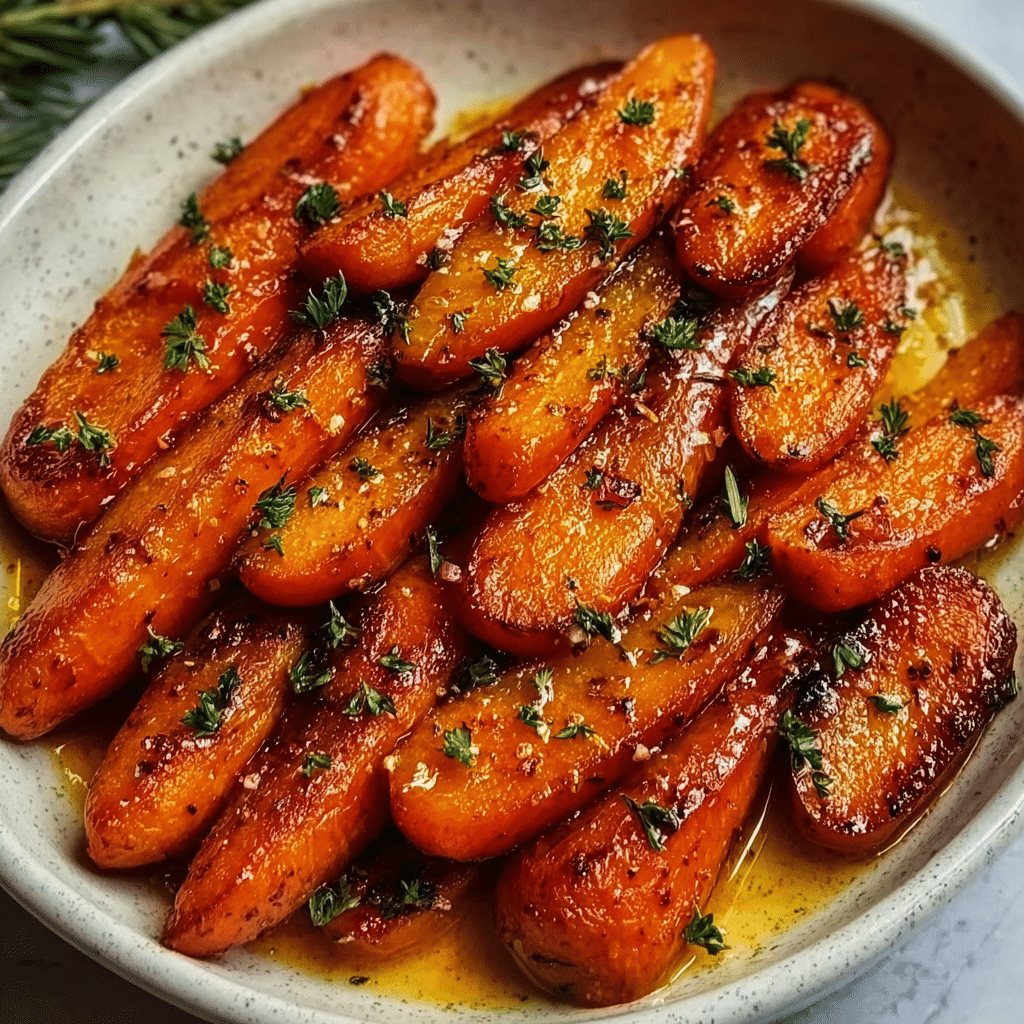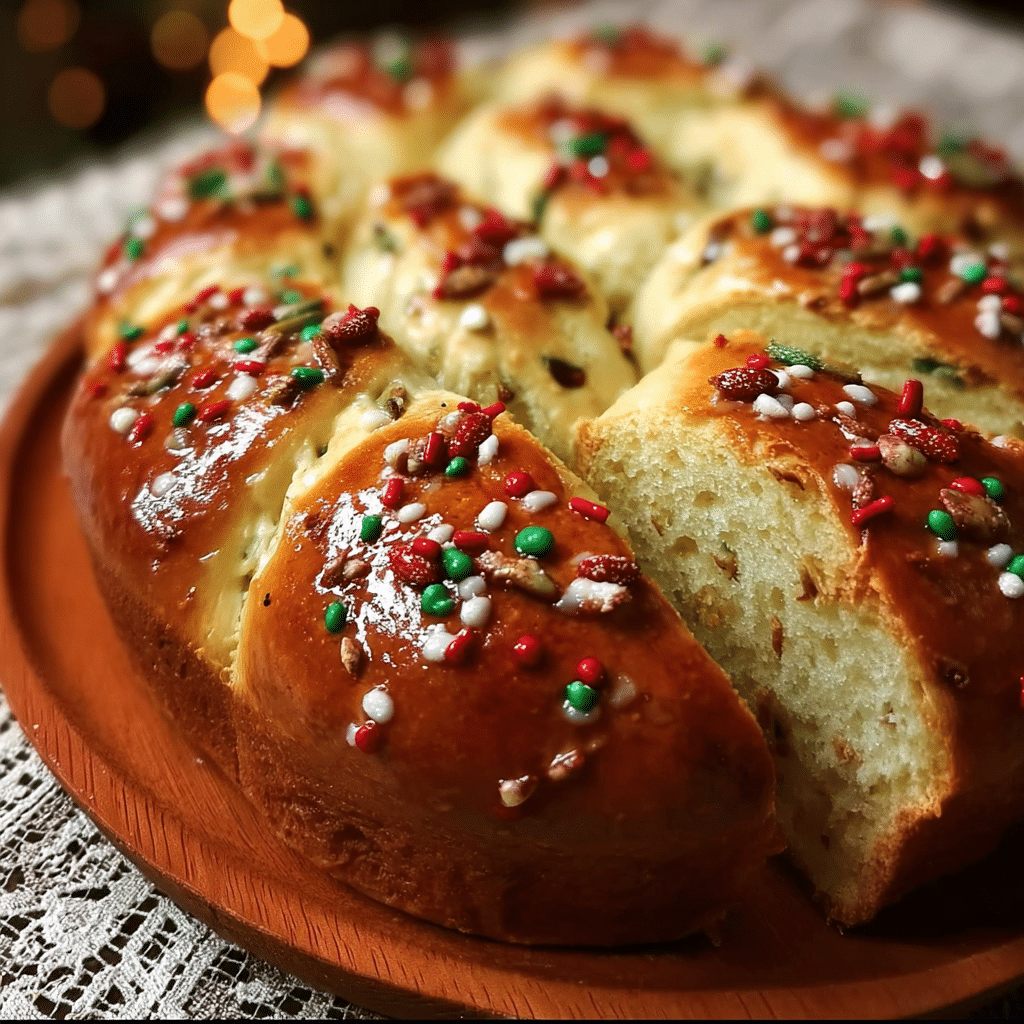Slow-braised beef roast has a way of warming not just the stomach but also the heart. I remember the first time I experienced this delightful dish; it was during a chilly autumn evening at my grandmother’s house. The aroma wafting through the kitchen was irresistibly inviting, pulling me away from my favorite board game to see what was cooking. As I entered, I was greeted by the sight of a perfectly browned roast nestled in a rich, dark sauce that glistened with hints of cranberry and balsamic vinegar. It was a moment that marked the beginning of my culinary love affair with slow-braised beef roast.
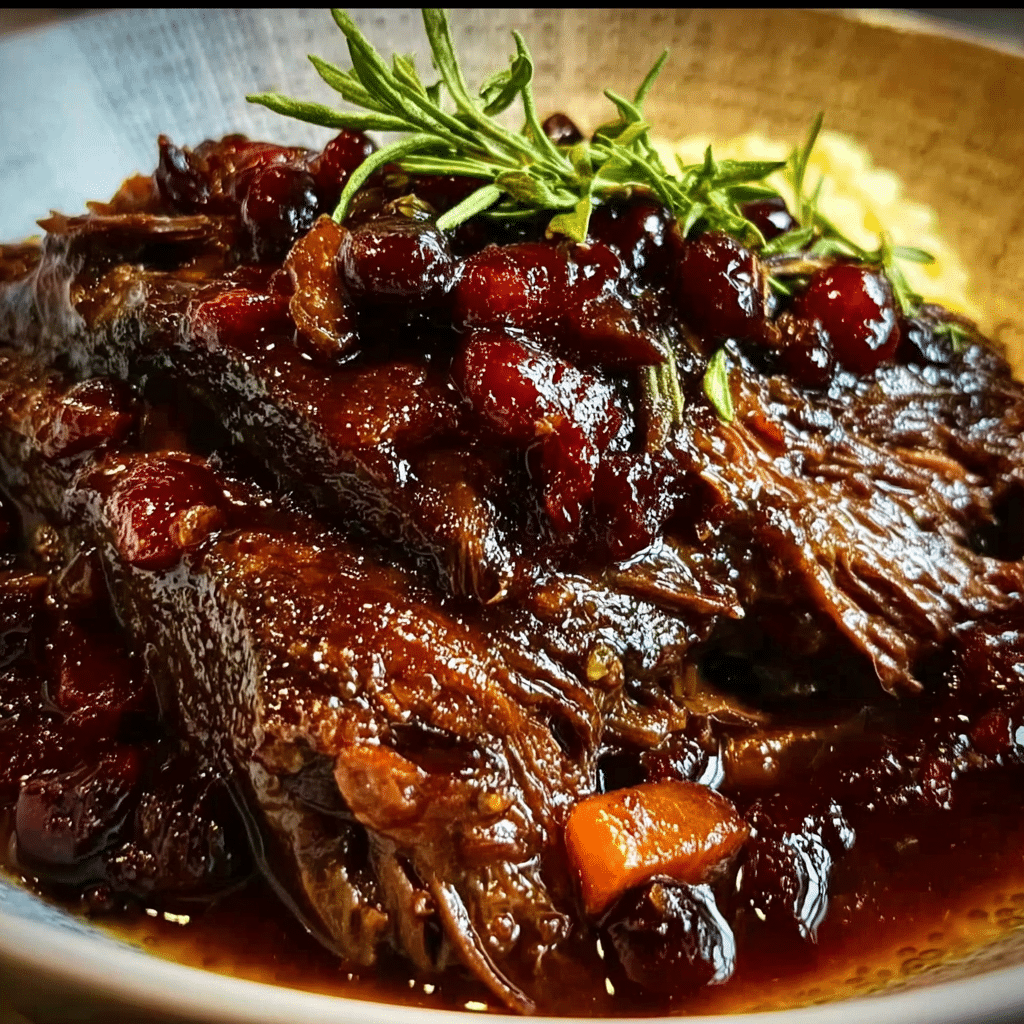
Growing up in a family where food was the centerpiece of every gathering, I quickly learned that cooking was a form of storytelling. Each recipe held secrets and memories, and the slow-braised beef roast was no exception. My grandmother explained that this dish had been passed down through generations, evolving from her own mother’s kitchen. It was a recipe rooted in the traditions of hearty, comforting meals that brought families together, especially during the colder months. As she recounted tales of her childhood, I could see the pride in her eyes, knowing she was sharing a piece of our family history with me.
The Story Behind This Recipe
Slow-braised beef roast is more than just a meal; it’s a canvas for family traditions and personal experiences. The beauty of this dish lies in its simplicity and versatility. It can be prepared for a cozy family dinner or dressed up for a festive gathering, making it a staple recipe in many households. One of the aspects that makes this dish truly special is how it transforms tough cuts of meat into tender, fall-apart goodness, infusing flavors that sing with every bite. The slow cooking process allows the meat to absorb the rich notes from the marinade, which typically includes ingredients like garlic, onions, and, of course, the sweet-tart magic of cranberry and balsamic vinegar.
This dish stands out not only for its flavors but also for the practicality it offers busy families. As someone who balances a hectic work life with family commitments, I appreciate recipes that allow me to spend less time in the kitchen without compromising on taste. The slow-braised beef roast is perfect for those evenings when you want to come home to a hot, hearty meal without the hassle of last-minute preparations. Simply season the roast, set it in the slow cooker or oven, and let the magic happen. By the time the family gathers around the table, the meal is ready to be enjoyed, and all the stress of the day melts away.
Why You’ll Love This Dish
The seasonal relevance of a slow-braised beef roast is undeniable. As the leaves turn and the air grows chilly, this dish becomes a comforting hug on a plate. It’s ideal for autumn and winter gatherings, when friends and family come together to celebrate and enjoy hearty meals. Picture a warm, inviting dining room filled with laughter and the soft glow of candlelight, a slow-braised beef roast at the center of it all, surrounded by seasonal sides like roasted root vegetables and fluffy mashed potatoes.
Beyond the delicious flavors and comforting nature of this dish, there’s an emotional connection that binds us to it. Food has a way of creating memories; every bite of slow-braised beef roast transports me back to those cherished evenings at my grandmother’s table. It’s a dish that encapsulates love, warmth, and togetherness, reminding us of the importance of family and the joy of sharing meals.
In this ultimate guide, readers will learn how to create their own slow-braised beef roast, complete with tips on selecting the perfect cut of meat, marinating techniques, and the best sides to accompany this beloved dish. Whether you’re a seasoned cook or a kitchen novice, get ready to embark on a culinary journey that will not only tantalize your taste buds but also create lasting memories around the dinner table.
The Rich History and Cultural Significance of slow-braised beef roast
The rich history and cultural significance of slow-braised beef roast is a fascinating journey that reflects the evolution of cooking practices over centuries. This dish, with its roots in rustic culinary traditions, showcases how people have learned to transform simple, tough cuts of meat into something extraordinary through slow cooking methods. The concept of braising itself dates back to ancient times when cooks discovered that cooking meat slowly in liquid not only made it tender but also infused it with rich flavors. This method was especially popular among farmers and those in rural communities, where hearty meals were essential for enduring long, hard days.
Origins and History
Slow-braised beef roast can trace its origins to several cultures, each adding its twist to this timeless dish. In Europe, particularly in France and Italy, braising was a common technique used to prepare tougher cuts of meat, which were often more affordable. The French term “braiser” refers to cooking with both dry and wet heat, allowing meat to sear and then simmer gently in a flavorful liquid. In Italy, one might find variations such as “brasato,” where the meat is marinated in wine before being slow-cooked, reflecting the Italian love for robust flavors.
In the United States, the slow-braised beef roast has become a staple in home kitchens, especially in Midwestern and Southern regions where hearty meals are a part of the culture. The introduction of cranberry and balsamic vinegar to the dish speaks to the American palate’s appreciation for sweet and tangy contrasts, making this version of the roast unique. As families began to gather around the table for Sunday dinners or holiday celebrations, the slow-braised beef roast became synonymous with comfort and togetherness.
Cultural Significance
This dish transcends mere sustenance; it symbolizes gathering and connection. Slow-braised beef roast is often reserved for special occasions and family gatherings, representing a time when loved ones come together to share stories, laughter, and love over a hearty meal. In many cultures, preparing this dish is a labor of love, requiring time and care to achieve the perfect balance of flavors. It’s common to see this roast served during holidays like Thanksgiving or Christmas, where it’s often the centerpiece of the feast, surrounded by side dishes that enhance its flavors.
Famous chefs and restaurants have also embraced the slow-braised beef roast, each offering their interpretation. Renowned chefs like Thomas Keller and Mario Batali have given this dish a gourmet spin, showcasing how versatile it can be, while still honoring its rustic roots. Their restaurants often feature variations that highlight seasonal ingredients, further enhancing the dish’s cultural relevance.
Nutritional Benefits
Beyond its cultural significance, slow-braised beef roast also carries nutritional benefits. Beef is a rich source of high-quality protein, necessary for muscle growth and repair, making it an excellent choice for families looking to provide nourishing meals. Additionally, the dish is often cooked with various vegetables, such as carrots, onions, and celery, which contribute vitamins and minerals essential for a balanced diet.
The slow cooking process helps retain nutrients and allows for flavor development, making every bite not only delicious but also wholesome. Moreover, when prepared with a cranberry balsamic glaze, the dish gains antioxidants from the cranberries, which can contribute to heart health and overall wellness.
As we explore the rich tapestry of slow-braised beef roast, we uncover not only its delectable flavors but also the stories and traditions that have shaped it over time. This dish invites us to gather around the table, share our lives, and create lasting memories—a reminder that food, at its core, is about connection.
Essential Ingredients for Perfect slow-braised beef roast
When embarking on the culinary adventure of crafting a slow-braised beef roast, the ingredients you choose are paramount in achieving not just a meal, but an experience. Every element plays a pivotal role in creating the rich flavors and tender textures that make this dish truly unforgettable. Let’s break down the essential ingredients you will need, along with insights into their importance, quality indicators, and even some tips for substitutions and storage.
Essential Ingredients
- 3 to 5 pounds ribeye roast: The star of your dish, ribeye roast is prized for its marbling and tenderness. When selecting a ribeye, look for a bright red color with a good amount of white fat running through it, which indicates flavor and juiciness.
- 1/2 cup balsamic vinegar: This tangy, sweet vinegar adds depth to the glaze. Opt for a high-quality balsamic that has a dense consistency and a rich flavor profile. The best balsamics are often aged, which enhances their complexity.
- 2 garlic cloves, minced: Garlic is a fundamental aromatic that enhances the overall flavor of the dish. Fresh garlic, with its sharp, pungent aroma, is best. Look for cloves that are firm and have a papery skin.
- 1/4 cup cranberry sauce: This adds a delightful sweetness and acidity that balances the richness of the beef. If you can, choose a homemade or high-quality store-bought cranberry sauce without additives.
- 2 tablespoons brown sugar: Brown sugar brings a hint of caramel sweetness to the glaze, complementing the tartness of the cranberries. Ensure it’s soft and moist for easy measuring.
- 1 teaspoon red pepper flakes: For those who enjoy a little heat, red pepper flakes add a subtle kick. Adjust the amount to your taste preference.
- Salt to taste: Seasoning is crucial in any dish. Using kosher salt is recommended as it has a more balanced flavor compared to table salt.
- 2 tablespoons olive oil: Olive oil not only helps in browning the beef but also adds a robust flavor. Go for extra virgin olive oil for the best taste.
- 2 tablespoons vegetable oil: This is used for searing the beef. A neutral oil with a high smoke point, like canola or grapeseed oil, works well here.
- 1/2 cup beef broth: Broth adds moisture and enhances the meaty flavor of your roast. Homemade is always best, but if you’re using store-bought, choose a low-sodium variety.
- 2 cups cranberries: Fresh cranberries are essential for that tart, vibrant flavor. When selecting cranberries, look for firm, plump berries without blemishes.
- 6 sprigs thyme: Fresh thyme provides an aromatic herbal note that complements the beef beautifully. When choosing thyme, make sure it’s vibrant green and fragrant.
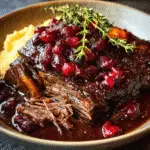
Slow-Braised Beef Roast with Cranberry Balsamic Glaze
Ingredients
- 3 to 5 pounds ribeye roast
- 1/2 cup Balsamic vinegar
- 2 garlic cloves, minced
- 1/4 cup cranberry sauce
- 2 tablespoons brown sugar
- 1 teaspoon red pepper flakes
- Salt to taste
- 2 tablespoons olive oil
- 2 tablespoons vegetable oil
- 1/2 cup beef broth
- 2 cups cranberries
- 6 sprigs thyme
Instructions
- Combine the balsamic vinegar, garlic, cranberry sauce, brown sugar, red pepper flakes, salt and olive oil in a large, re-sealable food storage bag (large enough to hold the beef roast). Reserve.
- Pierce the roast all over with a knife and place it in the bag. Close the bag and massage the roast with the marinade. Refrigerate overnight, turning the bag occasionally.
- Preheat oven to 350F degrees.
- Remove the roast from the marinade and wipe it with a paper towel to remove excess marinade.
- Heat the vegetable oil in a large cast iron pan, over medium heat. Place beef in hot pan and sear until deep golden brown on all sides.
- Add the marinade to the pan along with 1/2 cup beef broth and mix to combine. Add the cranberries and thyme and transfer the pan into the oven.
- Roast for about 20 min per pound of meat OR until a thermometer reads 140F degrees for medium rare.
- Remove from the oven and let rest for 15 minutes before carving and serving with the pan sauce.
Shopping Tips
When shopping for your ingredients, it’s best to visit local farmers’ markets or specialty grocery stores for the freshest produce and high-quality meats. Seasonal ingredients, like fresh cranberries, are typically available in the fall, so stock up during this time if you plan to make multiple roasts. For the ribeye roast, don’t hesitate to ask your butcher for recommendations or to cut you a specific size. They often have the best insights on quality and freshness.
Substitutions and Alternatives
If you have dietary restrictions or simply want to experiment, there are several substitutions to consider. For instance, if you prefer a leaner cut, you can use a chuck roast instead of ribeye, though it might require a slightly longer cooking time to achieve tenderness. If you need to avoid sugar, you could replace brown sugar with a sugar substitute such as honey or maple syrup, keeping in mind that this may alter the flavor profile slightly. For a gluten-free option, ensure your broth and sauces are certified gluten-free. Fresh herbs can be substituted with dried, though the flavor will be less intense—use one-third of the amount if you’re using dried herbs.
Lastly, always consider your ingredient storage. Fresh herbs like thyme should be wrapped in a damp paper towel and stored in the fridge for maximum freshness. Cranberries can be frozen if you buy them in bulk during their peak season. The same goes for your ribeye roast; if you’re not cooking it right away, wrap it tightly in butcher paper or plastic wrap and store it in the coldest part of your refrigerator.
Choosing the right ingredients for your slow-braised beef roast sets the foundation for a truly stunning dish. With the proper care and attention to detail, every bite will reflect the quality and flavor of what you’ve selected.
Detailed Step-by-Step slow-braised beef roast Cooking Instructions
Creating a stunning slow-braised beef roast is not just about the ingredients; it’s an art form that requires attention to detail, patience, and a bit of love. This section will walk you through each step of the process, ensuring that you achieve the perfect roast that’s tender, flavorful, and worthy of any dinner table. Grab your apron, and let’s get started!
Preparation Steps
- Gather Your Ingredients: Start by assembling all your ingredients on the counter. This step, known as mise en place, will help streamline your cooking process and ensure you have everything at hand.
- Preheat Your Oven: Preheat your oven to 325°F (163°C). A low temperature is essential for slow braising, allowing the tough fibers in the beef to break down gradually, resulting in a tender roast.
- Season the Ribeye: Generously season the ribeye roast with salt on all sides. This step is crucial; seasoning enhances the flavor and helps to create a delicious crust.
- Prepare the Marinade: In a bowl, combine the balsamic vinegar, minced garlic, cranberry sauce, brown sugar, and red pepper flakes. Whisk until well blended. This marinade will not only flavor the meat but also create a delicious glaze.
- Marinate the Beef: Place your ribeye roast in a large resealable bag or a dish and pour the marinade over it. Make sure to coat the roast evenly. Allow it to marinate in the fridge for at least 2 hours, preferably overnight for maximum flavor absorption.
Cooking Process
- Heat the Oils: In a large oven-safe pot or Dutch oven, heat the olive oil and vegetable oil over medium-high heat. The oils should shimmer but not smoke. This is the perfect time to get your pot hot enough for that perfect sear.
- Sear the Roast: Once the oils are hot, carefully place the marinated ribeye roast in the pot. Sear it on all sides for about 4-5 minutes until it develops a rich brown crust. This step locks in the juices and enhances the flavor.
- Add the Broth and Cranberries: After searing, remove the roast from the pot and set it aside. Pour in the beef broth and stir to deglaze the bottom of the pot, scraping up any browned bits. Return the roast to the pot, and add the fresh cranberries and thyme sprigs around it.
- Cover and Braise: Cover the pot with a tight-fitting lid and transfer it to the preheated oven. Braise the roast for about 3 to 4 hours, or until it reaches an internal temperature of at least 190°F (88°C). This slow cooking process allows the connective tissues to break down, resulting in meat that is fork-tender.
- Check for Tenderness: About an hour before your roast is done, start checking for tenderness using a fork. If the meat pulls apart easily, it’s ready. If not, continue cooking.
Final Assembly
- Rest the Roast: Once the roast is tender, carefully remove it from the oven and let it rest for 20-30 minutes. Resting allows the juices to redistribute throughout the meat, ensuring each slice is juicy.
- Prepare the Glaze: While the roast is resting, you can prepare the cranberry balsamic glaze. Remove the pot from the oven, and if desired, you can thicken the broth by simmering it on the stovetop for a few minutes.
- Slice the Roast: Using a sharp knife, slice the roast against the grain into thick slices. This helps to maintain tenderness and makes for a beautiful presentation.
- Plate and Serve: Serve the slices on a platter, drizzling the cranberry balsamic glaze over the top. Garnish with fresh thyme sprigs for a touch of color and flavor.
- Enjoy: Gather your family and friends around the table, and enjoy the fruits of your labor! This slow-braised beef roast is sure to impress and create lasting memories.
In this process, patience is key. The braising technique allows for flavors to meld beautifully, creating a meal that is as comforting as it is delicious. By following these detailed instructions, you will ensure that your slow-braised beef roast turns out perfectly every time.
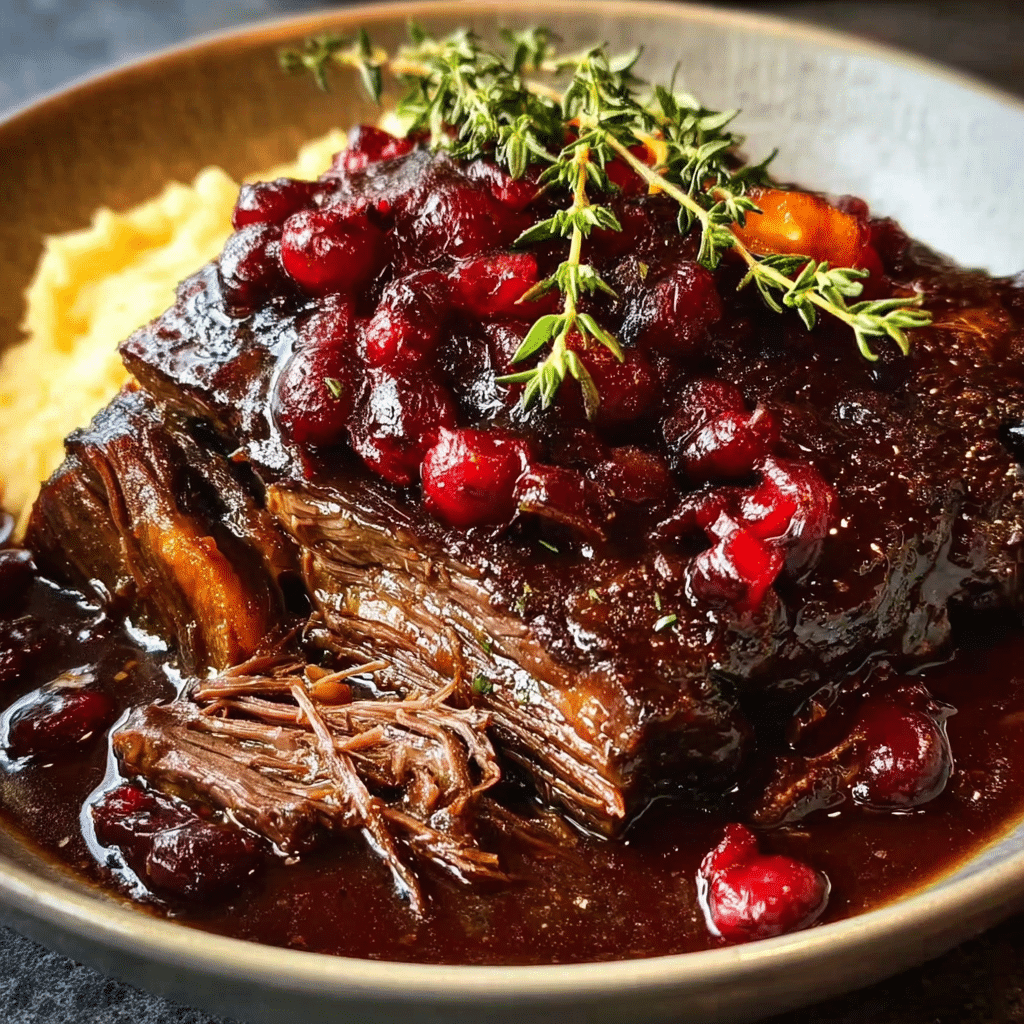
Professional Tips and Techniques for slow-braised beef roast
The allure of a slow-braised beef roast is not just in its flavor but also in the tender, melt-in-your-mouth texture that comes from hours of cooking. As a home cook who has spent countless weekends experimenting with recipes, I can share some professional tips and techniques to elevate your beef roast to new culinary heights. Whether you’re a novice or an experienced chef, understanding the nuances of slow-braising can transform your dish into a showstopper.
Professional Techniques
At its core, slow-braising is about patience and the right method. The first step is selecting the perfect cut of beef. While you can use various cuts, I recommend going for tougher cuts like chuck roast or brisket. These cuts have more connective tissue, which breaks down beautifully during the long cooking process, resulting in a rich, flavorful meat.
Before cooking, seasoning your beef roast is crucial. I often apply a dry rub of salt, pepper, and other spices a day in advance, allowing the flavors to penetrate the meat fully. This technique not only enhances flavor but also helps to develop a crust when searing the roast. Speaking of which, searing is a vital step in the slow-braising process. Heat a heavy-bottomed pot or Dutch oven over medium-high heat and sear the beef on all sides until browned. This creates the Maillard reaction, which adds depth of flavor and color to your dish.
Once your roast is seared, it’s time to add aromatics. Sautéing onions, garlic, and perhaps some carrots and celery in the same pot can help deglaze it, capturing all those delicious browned bits stuck to the bottom. Add your choice of liquid for braising—be it beef broth, red wine, or a combination of both. The liquid should come about halfway up the roast; you want it to steam and braise rather than boil. Cover the pot with a tight-fitting lid and transfer it to a preheated oven at a low temperature, typically around 300°F (150°C).
Troubleshooting Guide
Even the best cooks encounter challenges when preparing a slow-braised beef roast. One common issue is the roast coming out tough. This can occur if the meat isn’t cooked long enough or if it’s cooked at too high a temperature. Always trust your cooking times and use a meat thermometer to check for tenderness—you’re aiming for an internal temperature of around 190°F (88°C) for that perfect melt-in-your-mouth experience.
Another potential problem is excess liquid, which can dilute the flavors. If you find yourself with a watery broth after cooking, simply remove the roast and simmer the liquid on the stove until it thickens. You can also add a cornstarch slurry to give it a glossy finish. Lastly, if your roast seems dry after slicing, drizzle a little of the braising liquid over the top before serving to add moisture and flavor.
Presentation Tips
Presentation is key when serving a slow-braised beef roast. Once your roast is ready, take a moment to let it rest before slicing. This allows the juices to redistribute, ensuring each bite is tender and juicy. When it comes time to serve, slice the roast against the grain for the best texture. A beautiful platter with a sprinkle of fresh herbs, such as parsley or thyme, can elevate your dish visually.
To pair with your roast, consider serving seasonal vegetables or creamy mashed potatoes. A drizzle of the reduced braising liquid over the slices not only enhances the flavor but also adds a touch of elegance. For beverage pairings, a full-bodied red wine like Cabernet Sauvignon or a rich Malbec complements the flavors perfectly. The tannins in these wines cut through the richness of the beef, creating a harmonious dining experience.
Lastly, don’t forget to consider make-ahead strategies. A slow-braised beef roast tastes even better the next day, as the flavors continue to develop. You can prepare it a day in advance and store it in the fridge. Just reheat it gently before serving, and you’ll have a meal that’s as good as fresh.
Creative Variations and Adaptations of slow-braised beef roast
While a traditional slow-braised beef roast is a classic comfort food, there’s so much room for creativity in this dish. Throughout my culinary journey, I’ve discovered a myriad of variations that can cater to different tastes, dietary needs, and seasonal ingredients. Let’s explore some of these exciting adaptations together.
Seasonal Variations
One of the best aspects of cooking is utilizing seasonal ingredients to enhance your dishes. In the fall, for instance, consider adding root vegetables like sweet potatoes, parsnips, or pumpkin to your braising pot. They not only complement the robust flavor of the beef but also add a hint of sweetness that balances the dish beautifully. In the spring, fresh herbs such as rosemary, thyme, or even tarragon can brighten the flavor profile, giving your roast a refreshing twist.
In summer, you might opt for a lighter braising liquid, such as a mixture of white wine and chicken broth, paired with summer vegetables like zucchini and bell peppers. This approach keeps the dish vibrant and less heavy, perfect for warmer evenings. The key is to adjust your ingredients based on what’s available and fresh, making each roast unique.
Dietary Adaptations
In today’s culinary world, accommodating various dietary restrictions is essential. If you’re looking to create a slow-braised beef roast suitable for keto enthusiasts, focus on reducing carbohydrate-rich ingredients. Instead of using traditional flour-based thickening agents, you can make a rich sauce with pureed mushrooms or a low-carb alternative. For gluten-free options, ensure that any broth or sauces you use are certified gluten-free.
For those who follow a plant-based lifestyle, you can easily adapt the concept of slow-braising to create a hearty vegetable roast. Consider using a combination of hearty vegetables like eggplant, carrots, and mushrooms, simmered in a flavorful broth with spices. By following a similar cooking technique and allowing the vegetables to absorb the flavors, you can create a delectable dish that stands on its own.
Creative Twists
For the adventurous cook, why not explore international flavors? A Mexican-inspired slow-braised beef roast can be achieved by incorporating spices like cumin, coriander, and chipotle peppers into your braising liquid. Serve it with warm tortillas and a side of fresh salsa for a festive meal. Alternatively, a Moroccan twist with spices like cinnamon and saffron, paired with dried fruits such as apricots, can transform your roast into a fragrant, exotic dish.
When it comes to cooking methods, the slow cooker offers a convenient alternative to traditional oven braising. Simply follow the same seasoning and searing process on the stovetop, then transfer everything to your slow cooker. This method is fantastic for busy weekdays, allowing you to set it and forget it until dinner time. You can also use an Instant Pot for a quicker version, drastically reducing the cooking time while still yielding tender results.
As for leftovers, they can be a canvas for creativity! Shred leftover roast beef and mix it with barbecue sauce for delicious sandwiches, or incorporate it into a hearty beef stew with seasonal vegetables. The possibilities are endless, and each transformation can surprise and delight your palate.
In conclusion, the slow-braised beef roast is a versatile dish that can be adapted to reflect your culinary creativity and seasonal inspirations. Whether you keep it traditional or venture into new flavor territories, the essence remains the same: patience, love, and a willingness to explore the wonderful world of flavors.
Storage, Reheating, and Meal Prep for slow-braised beef roast
When it comes to enjoying a delightful slow-braised beef roast, understanding how to properly store, reheat, and prepare it in advance can make all the difference in preserving its rich flavors and tender texture. This section will guide you through the ins and outs of storage techniques that will keep your slow-braised beef roast tasting just as delicious as the day it was cooked.
Short-term Storage
After the culinary masterpiece of a slow-braised beef roast has been savored, you may find yourself with some leftovers. Proper short-term storage is crucial to maintaining the quality of your dish. Allow the roast to cool to room temperature before handling it. Avoid leaving it out for more than two hours to prevent bacterial growth.
Once cooled, slice or shred the beef if you prefer. This not only makes reheating easier but also allows the meat to absorb any remaining juices during storage. Place the beef in an airtight container, ensuring it’s tightly sealed. If you have any remaining glaze, consider storing it separately or drizzling it over the beef to enhance moisture retention.
In the refrigerator, your slow-braised beef roast will last for about 3 to 4 days. Ensure that your refrigerator is set at a temperature of 40°F (4°C) or below to maximize freshness. For best results, try to consume the leftovers within the first couple of days; this will enhance your experience and reduce food waste.
Freezing and Long-term Storage
If you find yourself with an abundance of slow-braised beef roast or simply want to prepare meals in advance, freezing is an excellent option. Freezing not only preserves the flavors but can also extend the shelf life to several months. Start by allowing the beef to cool completely before moving it into the freezer.
For freezing, it’s important to package the beef correctly to prevent freezer burn. Use heavy-duty freezer bags or vacuum-sealed containers. If using freezer bags, remove as much air as possible before sealing. Portioning the beef into meal-sized servings can also make it convenient to thaw just what you need without having to defrost the entire roast. Properly stored, your slow-braised beef roast can last in the freezer for up to 3 months without significant loss of quality.
When you’re ready to enjoy your frozen roast, the best method for thawing is to transfer it from the freezer to the refrigerator for 24 hours before reheating. This slow thawing process helps maintain the meat’s moisture and texture. Alternatively, if you are in a hurry, you can use the defrost setting on your microwave, but be cautious as this may affect the quality if not monitored closely.
Reheating Best Practices
Reheating your slow-braised beef roast can be a delicate process. The goal is to warm it through without drying it out. The best way to reheat is in the oven. Preheat your oven to a low temperature, around 250°F (120°C). Place the beef in an oven-safe dish and cover it with foil to retain moisture. Add a splash of beef broth or water to the dish to create steam, which can help keep the meat juicy. Heat for about 20-30 minutes, or until warmed through. If you’re in a rush, you can also reheat in a skillet over medium-low heat, adding a little broth or water to prevent sticking.
Microwaving can be a quick solution, but it’s essential to do so carefully. Place the beef in a microwave-safe dish, cover it with a lid or microwave-safe wrap, and heat in short intervals, checking frequently to ensure it doesn’t dry out.
When it comes to meal prep, slow-braised beef roast is incredibly versatile. You can use it in tacos, sandwiches, or as a main dish alongside vegetables. Preparing it in advance allows you to enjoy hearty meals throughout the week with minimal effort.
Lastly, food safety should always be a priority. When reheating, ensure the internal temperature of the beef reaches at least 165°F (74°C) to ensure it’s safe to eat. Additionally, always trust your senses—if the meat has an off smell or odd texture, it’s best to err on the side of caution and discard it.
By understanding the right techniques for storage, freezing, and reheating, you can ensure your slow-braised beef roast remains a delightful meal long after the initial cooking. Not only will you save time and reduce waste, but you’ll also be able to enjoy this comforting dish in a variety of recipes throughout the week.
Nutritional Benefits and Health Information
When we indulge in a slow-braised beef roast, we not only experience a burst of rich flavors but also enjoy a variety of nutritional benefits that come from its key ingredients. In this section, we’ll delve into the nutritional profile of this delightful dish, discuss its health benefits, and explore dietary considerations to give you a comprehensive overview of how it fits into a balanced diet.
Nutritional Profile
A typical serving of slow-braised beef roast (approximately 3 ounces) contains about 250-300 calories, depending on the cut of beef used and any additional ingredients like the cranberry balsamic glaze. The macronutrient distribution is quite favorable for those seeking a hearty meal; you can expect approximately 20-25 grams of protein, 15-20 grams of fat, and minimal carbohydrates (usually less than 5 grams), making it a protein-rich option for meat lovers.
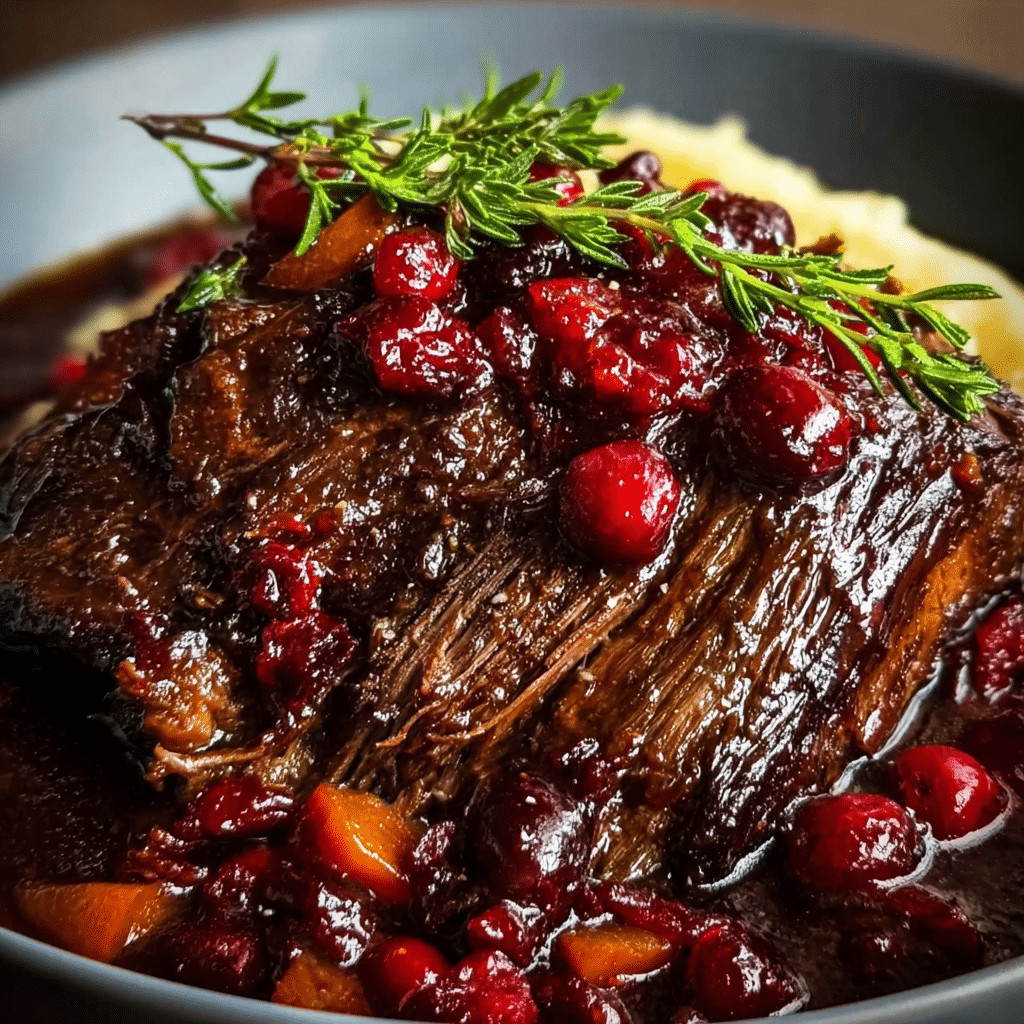
Aside from the macronutrients, slow-braised beef roast also provides essential vitamins and minerals. Beef is an excellent source of iron, zinc, and B vitamins, particularly B12, which is crucial for energy metabolism and neurological function. Iron, in particular, is vital for transporting oxygen throughout the body, which is why red meat is often recommended for individuals with iron deficiency.
Health Benefits
The health benefits of consuming beef, especially when slow-braised, are numerous. Firstly, the slow cooking process allows for the collagen in tougher cuts of beef to break down, rendering the meat not only tender but also rich in gelatin, which may support joint health. Additionally, the inclusion of ingredients like cranberries in the glaze can provide antioxidants that combat oxidative stress in the body.
Moreover, the protein content in slow-braised beef roast plays a crucial role in muscle repair and growth, making it an excellent meal option for those who are physically active. The healthy fats found in certain cuts of beef can also contribute to satiety, helping to keep you feeling full longer and potentially aiding in weight management.
Dietary Considerations
While slow-braised beef roast is a delicious and nutritious option, it’s essential to consider dietary restrictions and preferences. For those following a low-carb or ketogenic diet, this dish fits perfectly as it is low in carbs while high in protein and fat. However, for individuals on a vegetarian or vegan diet, this dish wouldn’t be suitable. Fortunately, there are plant-based alternatives that mimic the flavors of a beef roast, such as jackfruit or mushrooms, which can be slow-cooked with similar seasonings.
Additionally, those watching their sodium intake should be mindful of any pre-packaged sauces or glazes used in the preparation. Homemade versions can help control sodium levels while allowing you to customize flavors to your liking. Always check for allergens, especially if you’re using store-bought ingredients that may contain gluten or other common allergens.
In terms of calorie content, it’s important to consider what you serve alongside your slow-braised beef roast. Pairing it with a variety of vegetables not only enhances the meal’s nutritional profile but also adds fiber, which aids in digestion. Whole grains like quinoa or brown rice can complement the dish beautifully, providing additional nutrients and making it a well-rounded meal.
In comparison with similar dishes, such as pot roast or beef stew, slow-braised beef roast tends to have a more refined presentation while still delivering robust flavors. The slow cooking method allows the meat to retain moisture and tenderness, often making it a preferred choice for special occasions or family gatherings.
Ultimately, a slow-braised beef roast can be a nourishing, satisfying meal that fits well into a balanced diet. With its rich array of nutrients and flavors, this dish is not only a treat for the taste buds but also provides substantial health benefits. So next time you enjoy this delightful roast, remember that you are indulging in a dish that is as wholesome as it is delicious.
Frequently Asked Questions About Slow-Braised Beef Roast
Slow cooker beef roast with cranberry balsamic glaze
For a delicious slow cooker beef roast with cranberry balsamic glaze, start by searing your beef roast in a hot skillet to develop a rich, brown crust. This step enhances the flavor of the final dish. Once seared, place the roast in the slow cooker and combine cranberry sauce, balsamic vinegar, garlic, and herbs in a bowl, then pour this mixture over the meat. Cook on low for 8-10 hours or high for 4-6 hours, ensuring the roast becomes tender and infused with the glaze. Serve with mashed potatoes or roasted vegetables to soak up the delightful sauce.
Beef roast with cranberry balsamic glaze slow cook
To prepare a beef roast with cranberry balsamic glaze in a slow cooker, first season the beef with salt and pepper. After browning the roast in a pan, add it to the slow cooker with a mixture of cranberry sauce, balsamic vinegar, onion, and thyme for depth of flavor. Cooking on low heat for a longer period is ideal as it breaks down the tough fibers in the meat, resulting in a melt-in-your-mouth texture. Remember to check periodically for moisture; if the sauce is too thick, add a splash of beef broth or water. This dish pairs beautifully with crusty bread or a side salad.
Cranberry balsamic roast beef slow cooker
When making cranberry balsamic roast beef in the slow cooker, it’s essential to choose the right cut of meat, such as chuck roast or brisket, which are well-suited for slow cooking. After mixing cranberry sauce and balsamic vinegar with seasonings like rosemary and garlic, pour this mixture over the seared roast in the slow cooker. Cooking it on low for 8-10 hours ensures the meat absorbs the flavors and becomes tender. As a tip, consider adding vegetables like carrots and potatoes to the cooker for a complete meal. Serve the roast sliced with the glaze drizzled on top for an impressive presentation.
Cranberry balsamic glaze recipe
To create a cranberry balsamic glaze, combine 1 cup of cranberry sauce with 1/4 cup of balsamic vinegar in a saucepan. Add a tablespoon of honey or brown sugar to balance the tartness, along with a pinch of salt and pepper for seasoning. Heat the mixture over medium heat until it begins to simmer, then reduce to low and let it thicken for about 10-15 minutes, stirring occasionally. This glaze can be drizzled over meats, used as a marinade, or even as a salad dressing. For added depth, consider incorporating minced garlic or fresh herbs.
Beef with cranberry sauce
Beef with cranberry sauce is a delightful pairing that combines savory and sweet flavors. To prepare it, start by seasoning your beef cut and searing it to lock in juices. Once browned, you can either use store-bought cranberry sauce or make your own by combining fresh cranberries with sugar and water, simmering until the berries burst. Pour the cranberry sauce over the beef during the last hour of cooking to allow the flavors to meld without losing the sauce’s fresh taste. This dish is perfect for festive occasions and can be served alongside seasonal sides like roasted Brussels sprouts or sweet potatoes.
Balsamic Glazed roast beef
For balsamic glazed roast beef, start by marinating the beef in a mixture of balsamic vinegar, olive oil, garlic, and herbs for at least 30 minutes or overnight for deeper flavor. After marinating, sear the beef on all sides in a hot skillet to create a caramelized crust. Transfer the roast to the oven and brush with additional balsamic glaze, cooking until it reaches your desired doneness. A meat thermometer can help ensure accuracy, aiming for around 135°F for medium-rare. Let the roast rest before slicing to retain its juices, and drizzle any remaining glaze over the slices for an extra burst of flavor.
Cranberry Balsamic glazed ribeye roast
Preparing a cranberry balsamic glazed ribeye roast involves a few key steps to maximize flavor and tenderness. Start by seasoning the ribeye with salt and pepper, then sear it in a hot pan to develop a golden crust. Create the glaze by simmering cranberry sauce with balsamic vinegar and a dash of Dijon mustard for an added tang. Brush this glaze over the ribeye roast before placing it in the oven, allowing it to caramelize as it cooks. Aim for an internal temperature of about 130-135°F for a perfect medium-rare, and let it rest before slicing to ensure every bite is juicy and flavorful.
Roast cranberry sauce
Roast cranberry sauce is a versatile condiment that can elevate various dishes, especially meats. To make it, toss fresh cranberries with sugar, orange zest, and a splash of balsamic vinegar, then roast in the oven until the cranberries burst and caramelize. This method enhances the natural sweetness and adds depth to the flavor profile. You can adjust the sweetness by varying the sugar and add spices like cinnamon or ginger for warmth. This sauce pairs excellently with turkey, pork, or beef, making it a great addition to holiday meals or any festive gathering.
Conclusion: Mastering the Perfect slow-braised beef roast
Creating the perfect slow-braised beef roast is more than just following a recipe—it’s about understanding the techniques, ingredients, and cultural significance behind this beloved dish. Throughout this comprehensive guide, we’ve explored everything from the historical origins to modern variations, ensuring you have all the knowledge needed to make this recipe your own.
Whether you’re a beginner cook or an experienced chef, the techniques and tips we’ve shared will help you create a slow-braised beef roast that’s not only delicious but also meaningful. Remember that cooking is a journey of discovery, and each time you make this dish, you’ll learn something new.
We encourage you to experiment with the variations we’ve discussed, adapt the recipe to your dietary needs, and most importantly, share it with the people you love. Food has the incredible power to bring people together, and Slow-Braised Beef Roast with Cranberry Balsamic Glaze is the perfect dish to create lasting memories around your dinner table.

